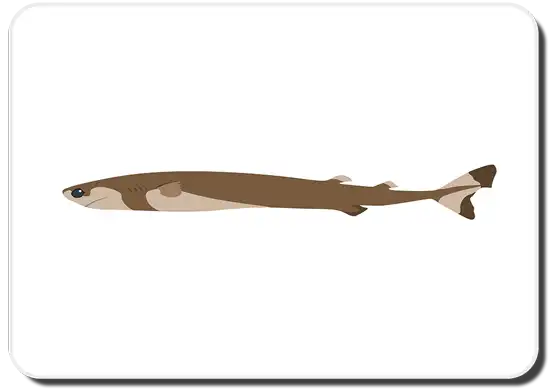The Cookiecutter Shark (Isistius brasiliensis) is a member of the “Sleeper Shark” family, Dalatiidae. This group in turn belongs to Order Squaliformes, the Dogfish Sharks. Physically it looks like a typical dogfish, with a long thin body, a short cone-shaped snout, and no anal fin. The skin is greyish brown, with a darker brown area around the throat and gills, and a lighter belly.
The Cookiecutter Shark is named after the cookie-shaped wounds that it leaves on the bodies of its prey. This small fish is also known as the cigar shark because of its body shape. It lives in the deep-waters of warmer areas worldwide. Adult males can grow up to 42 cm (16.5″) long, and females grow a little larger, up to 56 cm (22″) in total length.

Habitat and Range
Map Of The Cookiecutter Shark Shark’s Habitat

The Cookiecutter is a wide-ranging pelagic shark that lives in the temperate and tropical waters of the Atlantic and Pacific Oceans, around the globe.
It is often found close to islands: this could be because there is a higher concentration of prey, for better mating opportunities, or because areas around islands provide ideal nursery habitat. All of these possibilities have been suggested but no evidence is available to distinguish among them.
These fish are typically found in deep water below 3,281 feet (1000 m) in the daytime, but have been recorded to depths of 3.7 km (2.3 mi).
Feeding Behavior
At night, Cookiecutter Sharks move closer to the surface to feed, but they still stay at least 90 m (300 ft) deep. The feeding method is very curious: although this species is rather small, it uses the unique teeth in its round mouth to take cookie-sized bites from the flesh of larger marine creatures, like dolphins. The bites are not fatal.
This shark’s mouth is unmistakable: the small teeth in the upper jaw are erect, and the teeth in the lower jaw are large and triangular.
The light emitted from the shark’s belly attracts larger fish. The dark patch of the throat, against the glow of the underside, is thought to appear like a small fish when viewed from deeper waters. This draws in the larger prey that are looking for a meal.
Then, just prior to reaching the Cookiecutter, the larger fish is surprised by the shark. (Pretty ingenious and brave of the little guy, huh?) The shark attaches to the prey using its strong, sucking lips, and then the efficient teeth go to work, almost like a can-opener. Targets commonly include large fish such as marlin, tuna, other sharks and stingrays, and marine mammals including seals and whales. The diet can also include whole squid and crustaceans.
Social Behavior
Aside from the feeding method, little is known about these sharks’ biology. They are believed to be mostly solitary, interacting with other members of the species mainly to mate. (However one report suggested that “schools” of these sharks would be very attractive to large prey items, for the bioluminescence would make them look like a school of tiny fish).
Other species that feed on the Cookiecutter include sharks and other larger fish.
Breeding
Male Cookiecutters reach maturity at about 36 cm (14″) and females mature at roughly 40 cm (16″). This species is ovoviviparous, giving birth to pups that develop inside egg cases within the mother. Each litter contains 6-12 live young that are born after 12-22 months. They are fully developed at birth, already able to hunt.
Humans and Conservation
Fishers only occasionally trap Cookiecutter Sharks, because they are so small. This usually happens at night, when the sharks move toward the surface to feed and are thus more likely to be netted. The species targets larger, sought after fish as prey, but this does not have much of an economic effect on fisheries.
Cookiecutter Sharks are not considered dangerous to people because they reside in deep-water habitat. However, the first documented bite of a human – a long-distance ocean swimmer – was reported recently (Honebrink et al. 2011). The authors suggest that people entering deep waters at night, in the range of this shark, should be aware.
The conservation status of this species, according to the IUCN Red List, is “Least Concern”.
There is little worry because of its wide distribution, deep-water habitat (making it harder to catch accidentally), and lack of interest to fisheries.
13 Amazing Facts About The Cookiecutter Shark
The Cookiecutter Shark, also referred to as the cigar shark, is a fascinating creature with unique biological features and a penchant for large prey. Here are 13 interesting facts about your new favorite shark!
1. They take cookie-shaped bites!
The Cookiecutter Shark gets its name from the cookie-shaped bite wounds it leaves on its prey. The shark’s unique teeth and short, coned snout create these round chunks. It will attach itself to a tuna, marlin, stingray, another shark, or even a whale, by suctioning its lips to the body of the animal. Then, the shark spins its body, using it’s lower set of serrated teeth like a can opener to remove a hunk of flesh, resulting in a wound that lives up to the shark’s name.
2. And speaking of names… they’ve had 3!
They’ve had three scientific names, that is. When the shark was discovered in 1824, it was named Tristius brasiliensis, followed by Scymnus brasiliensis, and, finally, its current name, Isistius brasiliensis. It gets its genus name from Isis, the Egyptian goddess of light. And the species name references one of the places it can be found, off the coast of Brazil.
3. They glow!
Cookiecutter Sharks are dark brown to black on the upper side of their body, which is know as the dorsal side; and a lighter brown on the lower side, known as the ventral side. Their gill regions have a dark collar around them. The whole ventral surface, minus this dark collar, is covered in a dense network of tiny photophores. These emit a greenish glow called bioluminescence.
4. They keep glowing!
Researchers have observed this glow to last as long as three hours after the shark’s death!
5. They are sneaky predators by design!
Not only does the emitted glow attract fish, but also the dark patch on the shark’s ventral surface resembles a smaller fish when viewed from below. This marking is believed to lure larger fish and other potential prey that may be swimming underneath it.
6. They lose all of their teeth at once!
Unlike other sharks that shed teeth one a time, the Cookiecutter Shark loses all of their teeth in a single shedding. It even swallows the bottom row. All 25 to 31 of them! It is believed that this is to provide calcium to the body. Cookiecutters also have 30 to 37 smaller upper teeth.
7. They are deep-water creatures!
You are not likely to see the Cookiecutter Shark in shallow alcoves. They are often found swimming in depths below 3,281 feet (1000 meters), and have even been discovered at 3.7 km (2.3 miles) deep. They stick to the warm, tropical areas of the Atlantic and Pacific Oceans, primarily near coastal islands where food is more plentiful.
8. They are ovoviviparous!
This means that shark pups hatch from eggs inside the mother’s uterus and then are birthed. It takes between 12-22 months for these eggs to hatch, and a mother will typically birth 6-12 pups per litter. The pups come out fully developed and able to hunt for food by themselves.
9. They are small, but mighty!
The male Cookiecutter grows to a maximum of 16.5 inches (41.91 centimeters), while females grow to 22 inches (55.88 centimeters). Despite its size, it often targets larger prey, including whales and seals. It is not known to attack humans, though, and there is only one reported case of a Cookiecutter bite on a human in recent recorded history.
10. Oily livers = floating through waters with ease!
The Cookiecutter Shark’s elongated body cavity is filled with an enormous, oily liver. In fact, the liver accounts for approximately 35% of its total body weight! The low-density oils in the liver means that this shark has relatively neutral buoyancy, allowing for easy movement through a wide range of depths with minimal energy loss. In other words, it can stop swimming and it won’t sink!
11. They have atypical eyes!
With its large eyes, the Cookiecutter can visually lock onto its prey well before it physically does. Unlike other sharks, the Cookiecutter Shark’s retina has ganglion cells in a concentric area (versus the horizontal streak that is typical) that may be the reason for such binocular focus.
11. They can be quick!
The broad caudal fin allows the shark to rapidly accelerate over short distances, quickly ambushing its unsuspecting victims.
12. They enjoy family time!
The Cookiecutter Shark has been known to travel in schools. This could be another reason why they are so effective at luring prey- and why they are less likely to be preyed upon!
13. They can be mischievous!
During the 1970s, Cookiecutter Sharks were the reason several United States Navy submarines were forced back to base. The Navy had to repair damage to the shark-bitten neoprene boots of sonar domes. The bites caused the sound-transmitting oil inside to leak, impairing their ability to navigate. Fiberglass covers around the domes solved that problem.
In the 1980s, around thirty U.S. Navy submarines were damaged by Cookiecutter Shark bites, mostly to the rubber-sheathed electric cable leading to the sounding probe used to ensure safety when surfacing in shipping zones. Again, the solution was to apply a fiberglass coating.
And there you have it! Cookiecutter Sharks have unique qualities, from the shape of their bites, to their feeding habits, to their mischievous tendancies! It is important that, while they are not on the endangered list, we protect their habitats and food sources, lest they find their way of the list like many of their shark cousins.
Sources
Written By: by Kara Lefevre
Berger M & G (2000). What do sharks eat for dinner? Questions and answers about sharks. Scholastic Inc., NY.
Florida Museum of Natural History
Honebrink R, Buch R, Galpin P & Burgess G (2011). First documented attack on a live human by a Cookiecutter Shark (Squaliformes, Dalatiidae: Isistius sp.). Pacific Science 65: 365-374.
Milius S (1998). Glow-in-the-dark shark has killer smudge. Science News 154 (5): 70.
Stevens J (2003). Isistius brasiliensis. In: IUCN 2012. IUCN Red List of Threatened Species. Version 2012.2.
